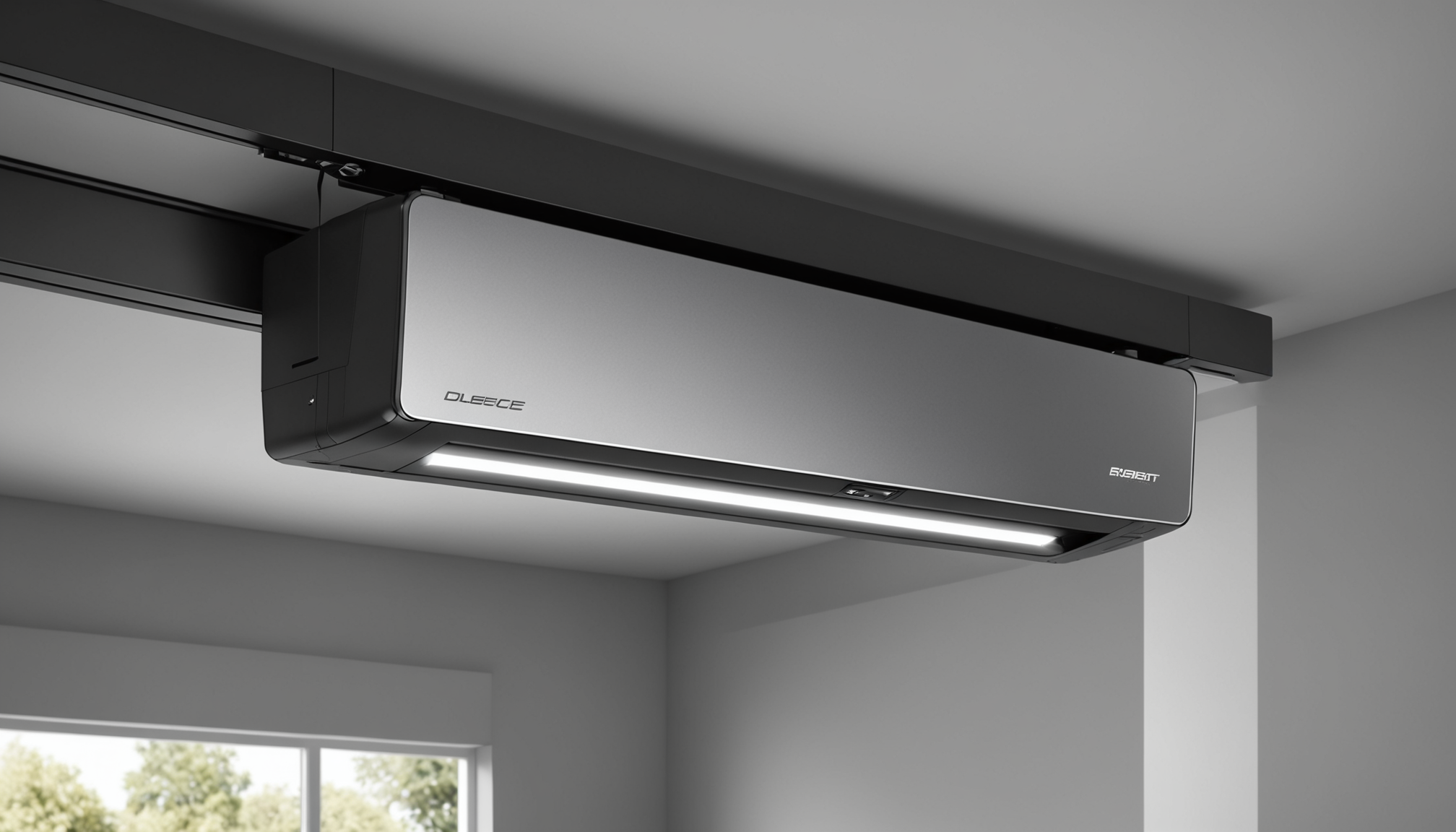Garage door openers have become an essential part of modern home convenience, offering homeowners a combination of security, ease, and functionality. As you explore your options for a new or replacement garage door opener, it is important to understand the different types available in the market. Each type comes with its own pros and cons, and understanding these can greatly aid in making an informed choice. Here, we’ll delve into the main types of garage door openers and provide a comparative analysis to help you discern which might be best suited for your needs.
The most common types of garage door openers are chain drive, belt drive, screw drive, and direct drive models. Each of these operates in a unique way and offers distinct benefits that make them suited for different applications and household requirements.
Chain drive openers are the most traditional and widely used type. They operate by using a metal chain to push or pull a trolley that moves the garage door up and down. Though they are particularly noisy, they are known for their durability and affordability. This makes them a popular choice for detached garages where noise is not a primary concern.
Belt drive openers, on the other hand, operate in a similar fashion to chain drive systems but utilize a belt rather than a chain. The belt can be made from materials such as fiberglass, steel-reinforced rubber, or polyurethane, and this design offers much quieter operation. Because of their silent functionality, belt drives are ideal for attached garages situated close to living spaces. However, they tend to be more expensive than chain drive models.
Screw drive openers utilize a threaded steel rod to move the trolley that opens and closes the garage door. They have fewer moving parts compared to chain and belt drive openers, which often results in less maintenance. They are also quieter than chain drives but may present performance challenges in extreme temperatures. Screw drive openers offer a middle ground between cost and noise level, making them an appealing option for many homeowners.
Lastly, direct drive openers represent a more modern solution. In these systems, the motor itself moves along a stationary chain, resulting in extremely quiet operation. They also boast reliable and maintenance-free performance due to their minimal moving parts. This type of opener is particularly beneficial for homes with living spaces adjacent to or above the garage.
To aid in your selection process, the following table offers a comparative view of these garage door opener types, highlighting key factors such as price, noise level, and maintenance needs:
| Type | Price | Noise Level | Maintenance Needs |
| Chain Drive | Low | High | Moderate |
| Belt Drive | Moderate to High | Low | Low |
| Screw Drive | Moderate | Moderate | Low to Moderate |
| Direct Drive | High | Very Low | Very Low |
Understanding these fundamental differences can guide you in selecting the opener that perfectly aligns with your priorities, whether they be budget constraints, noise sensitivity, or ease of maintenance. As you weigh these factors, you can select a garage door opener that not only provides robust operation but also meets the specific needs and lifestyle of your household.
key features to consider
When choosing a garage door opener, several key features play a pivotal role in determining the best fit for your home. These features not only enhance the functionality and convenience of the garage door system but also ensure reliability, safety, and ease of use over time.
- Horsepower: The motor’s horsepower is a critical factor, as it must match the size and weight of your garage door. Residential doors typically require motors ranging from 1/2 HP to 1 HP. A standard single-car garage door may operate well with a 1/2 HP motor, while heavier double-car or insulated doors might necessitate a 3/4 HP or more powerful motor for optimal performance.
- Drive System: The type of drive system can significantly affect the opener’s noise level and cost. As previously discussed, chain drives are durable but noisy, belt drives offer quieter operation ideal for attached garages, and screw drives strike a balance between noise and cost. Direct drives provide the quietest operation, suitable for homes with living spaces near the garage.
- Remote Control Options: Consider the availability of remote controls and the range they cover. Many modern systems offer multiple remotes for different family members, and some even include a keyless entry pad. The addition of smartphone compatibility, where you can operate your garage door through an app, is rapidly becoming a standard feature, enhancing convenience and control.
- Safety Features: Look for essential safety mechanisms such as auto-reverse, which automatically stops and reverses the door if it encounters an obstacle. This feature is especially crucial for households with children or pets. Modern openers also include motion sensors and lights that activate upon entry, providing added visibility and security.
- Battery Backup: In the event of a power outage, a battery backup system ensures your garage door can still be operated, either via remote or manually. This feature provides peace of mind and maintains accessibility to your garage at all times.
- Smart Features: Integration with home automation systems can offer additional control options. Features such as voice commands via virtual assistants, compatibility with smart home networks, and real-time activity alerts enhance the user’s experience and security.
- Lighting: Adequate lighting is important for safety and ease of use, especially in garages that do not receive natural light. Many modern openers come equipped with built-in LED lights that can be controlled separately from the door’s operation.
- Security Measures: Look for features like rolling code technology, which changes the access code each time the remote is used. This prevents code grabbing and unauthorized access to your garage.
- Warranty and Support: A good warranty not only offers protection but also reflects the manufacturer’s confidence in their product. Consider the length and terms of the warranty provided, and opt for brands with strong customer support networks for ease of assistance and repairs, if necessary.
By evaluating these features, you can select a garage door opener that complements your needs, aligns with your lifestyle, and enhances the overall functionality of your home. Prioritizing these aspects ensures that the opener you choose delivers performance, safety, and reliability for years to come.
installation and maintenance tips
Installing a garage door opener can seem daunting, but with the right preparation and guidance, it can be a straightforward process. One of the first and most crucial steps is to thoroughly read the manufacturer’s installation manual. Each unit may have unique requirements and safety protocols, making it essential to follow the included instructions.
Begin by gathering all necessary tools and equipment to ensure a smooth installation process. Common tools required include a power drill, various screwdrivers, wrenches, pliers, and a ladder. Most installations will also require specific screws and brackets, often provided with the opener, so it’s important to verify that all components are present.
Before you start assembling the hardware, it’s critical to verify the alignment of the garage door. A poorly balanced door can lead to premature wear and potential safety hazards. You can test it by manually lifting the door halfway; if it stays in place, it’s likely balanced. If not, adjust the tension springs for even balance before proceeding.
Attaching the opener to the ceiling and ensuring the motor unit is securely mounted is the next step. Use a stud finder to locate ceiling joists, as anchoring the unit to these will provide the necessary support. For homes with unfinished ceilings, employing angle iron can provide additional support and stability.
Once installed, focus on the drive rail assembly and attach it to the motor unit. The rail needs to be level, as any incline or decline could affect the performance of the opener. A spirit level can be a handy tool here, ensuring the rail remains perfectly horizontal during installation.
Next, concentrate on the connection between the opener and the garage door. This usually involves attaching a trolley that will connect to an arm on the garage door. Ensure this connection is secure, as the reliability of your door’s movement hinges on this attachment.
After assembly, it’s important to program the control settings and test the system. Most units come with preset settings, but they often require customization based on your door’s height and weight. Adjust the limits of the door travel and force settings, which control how far the door opens and closes and with how much effort, respectively. Many modern openers have auto-programming features that simplify this step.
Regular maintenance is equally essential for the longevity of your garage door opener. Start by regularly checking the brackets and fasteners, tightening any that may have loosened over time. Lubricate all moving parts every six months, focusing on the rollers, hinges, and tracks to keep them functioning smoothly and quietly. Also, clean the sensors to ensure uninterrupted communication. Dust and debris can sometimes cause sensors to malfunction, leading to false readings or operational errors.
It’s also vital to test safety features periodically, such as the auto-reverse mechanism. Place a small, immovable object under the door and attempt to close it. If the door does not reverse upon contact, consult the manufacturer’s guidelines for adjustments.
Finally, consider the climate in your area. In areas with extreme weather conditions, regular inspections can help prevent weather-related wear, such as corrosion or warping. This proactive approach to maintenance will ensure your garage door opener remains efficient and reliable, reducing the risk of unexpected malfunctions or repairs.
By following these steps for installation and adhering to a consistent maintenance schedule, you can maximize the performance and lifespan of your garage door opener, ensuring it operates seamlessly for years to come.
safety and security considerations
To protect both your property and loved ones, it is crucial to consider various aspects of safety and security when selecting a garage door opener. Modern units are equipped with numerous features designed to enhance the security of your home and prevent accidents and unauthorized access.
First, look for openers that integrate rolling code technology. This feature changes the entry code every time the remote control is used, making it incredibly difficult for potential intruders to intercept and reuse access codes. This dynamic security measure prevents what is commonly known as “code grabbing.”
Another essential feature to consider is the presence of a dependable auto-reverse system. If the garage door encounters an obstruction while closing, the auto-reverse mechanism stops and reverses the door, minimizing the risk of injury to pets, children, or damage to objects inadvertently left in its path. Regular testing of this feature is advised to ensure it functions correctly, as it plays a critical role in preventing accidents.
Motion detection sensors are also a valuable addition to any garage door opener system. These sensors can activate lights when there is movement, improving visibility and deterring potential intruders by signaling that the area is under observation. Enhanced lighting options such as built-in LED lighting can further bolster security, illuminating the garage for safely parking vehicles and navigating the space during the night.
In terms of preventing unauthorized access, smart technology is revolutionizing garage door openers. Many modern openers offer integration with smartphone apps, allowing you to monitor and control your garage door from virtually anywhere. This remote operation capability means you can close your garage door even if you’ve left home and forgot to do so or open it for a delivery driver when you’re not available in person. Some systems can send real-time alerts if the door is opened unexpectedly, providing peace of mind regarding the security of your home.
Moreover, keep an eye out for the manual release mechanism built into the opener for emergencies. Understanding how to operate it is essential, especially in cases of power outages, allowing you to open or close your garage door manually.
For areas prone to power failures, opting for a garage door opener with a battery backup is indispensable. This feature ensures that the door remains operational during outages, maintaining home security and accessibility. It also prevents the inconvenience and vulnerability associated with being unable to use your garage when the power is down.
Incorporating these safety and security features into your decision-making process can substantially enhance the protection of your home. By prioritizing these elements, not only do you ensure seamless operation of your garage door, but you also fortify your household against potential threats, accidents, and the uncertainties of power interruptions.
choosing the right model for your needs
Selecting the right model for your unique needs involves a careful assessment of your specific circumstances, preferences, and priorities. The first step is to consider the type of garage you have and its proximity to living spaces. If noise is a concern because of attached bedrooms or living rooms, a belt or direct drive opener would be preferable due to their quiet operation. Conversely, if your garage is detached and sound is not an issue, a cost-effective chain drive opener might suffice.
Assessing your garage door’s size and weight is also crucial. Heavier, larger doors, such as double-car garage doors or solid wood constructs, would benefit from a more powerful motor—typically 3/4 HP or higher—to ensure smooth operation and longevity of the motor. On the other hand, lighter single-car garage doors may effectively operate with a 1/2 HP motor, aligning with both performance requirements and budget constraints.
Consider your budget as well, as different models come with varying price points. If your budget allows, investing in a model with advanced features like smart technology integration, enhanced safety features, and battery backup can deliver significant added value. However, if you’re focusing on essentials, a basic model with robust mechanics and standard safety features might be more appropriate.
Moreover, it is essential to evaluate your desire for smart features. Many modern models now offer compatibility with home automation systems. These features allow you to operate your garage door remotely, receive status alerts, and integrate it with other smart devices for a cohesive home automation experience.
Finally, consider the climate where you live. If you experience extreme temperatures, it might be best to opt for a model that performs well in such conditions, like belt or screw drive openers. These can handle temperature fluctuations more effectively without affecting door operation.
With an understanding of these aspects, you can focus on a model that precisely fits your needs, providing the benefits of an optimized garage door opener. Whether ease of installation, maintenance, integration into a smart home, or minimal noise is your main goal, prioritizing these factors ensures that the opener you select caters to your unique requirements, ultimately enhancing your home’s functionality and comfort.
In conclusion, choosing the right garage door opener involves weighing various factors, including types, features, installation considerations, and safety measures. By carefully evaluating these aspects and aligning them with your specific needs and preferences, you can select a model that offers optimal performance, safety, and convenience for your home. A well-chosen garage door opener not only enhances the operation of your garage door but also adds to the overall functionality and security of your household, giving you peace of mind and ease of access for years to come.


